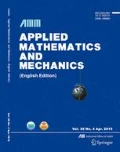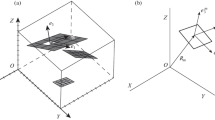Abstract
In the investigation on fracture mechanics, the potential function was introduced, and the moving differential equation was constructed. By making Laplace and Fourier transformation as well as sine and cosine transformation to moving differential equations and various responses, the dual equation which is constructed from boundary conditions lastly was solved. This method of investigating dynamic crack has become a more systematic one that is used widely. Some problems are encountered when the dynamic crack is studied. After the large investigation on the problems, it is discovered that during the process of mathematic derivation, the method is short of precision, and the derived results in this method are accidental and have no credibility. A model for example is taken to explain the problems existing in initial deriving process of the integral-transformation method of dynamic crack.
Similar content being viewed by others
References
Shindo Y, Katsure H, Yan W. Dynamic stress intensity factor of a cracked dielectric medium in a uniform electric field[J].Acta Mech,1996:117(1–4):1–10.
Li S, Mataga P A. Dynamic crack propagation in piezoelectric materials—Part I: Electrode solution[J].J Mech Phys Solids,1996,44(11):1799–1830.
Li S, Mataga P A. Dynamic crack propagation in piezoelectric materials—Part II: Vacuum solution[J].J Mech Phys Solids,1996,44(11):1831–1866.
Chen Z T, Yu S W. Anti-plane Yoffe crack problem in piezoelectric materials[J].Int J Fractrue, 1997,84(3):L41-L45.
Chen Z T, Karihaloo B L. Dynamic response of a cracked piezoelectric ceramic under arbitrary electro-mechanical impact[J].Int J Solids Struct,1999,36(3):5125–5133.
WANG Zhu-xi, GUO Dun-ren.Spcial Function Introduction[M]. Beijing: Science Press, 1979. (in Chinese)
FAN Tian-you.Fracture Dynamics Introduction[M]. Beijing: Beijing Science and Technology University Press,1990. (in Chinese)
Busbridge I W.Proc London Math Soc, 1838,44:115–124.
HOU Mi-shan, MEI Fu-liang. Problems of antiplane strain of electrically permeable cracks between bonded dissimilar piezoelectric materials[J].Chinese Science Bulletin, 1998,43(4):341.
Freund L B.Dynamic Fracture Mechanics[M]. Cambridge: Cambridge Press, 1990.
Author information
Authors and Affiliations
Additional information
Contributed by WANG Biao
Biography: BIAN Wen-feng (1963 ∼), Associate Professor, Doctor
Rights and permissions
About this article
Cite this article
Wen-feng, B., Biao, W. & Bao-xian, J. Mathematical problems in the integral-transformation method of dynamic crack. Appl Math Mech 25, 252–256 (2004). https://doi.org/10.1007/BF02437327
Received:
Revised:
Issue Date:
DOI: https://doi.org/10.1007/BF02437327



